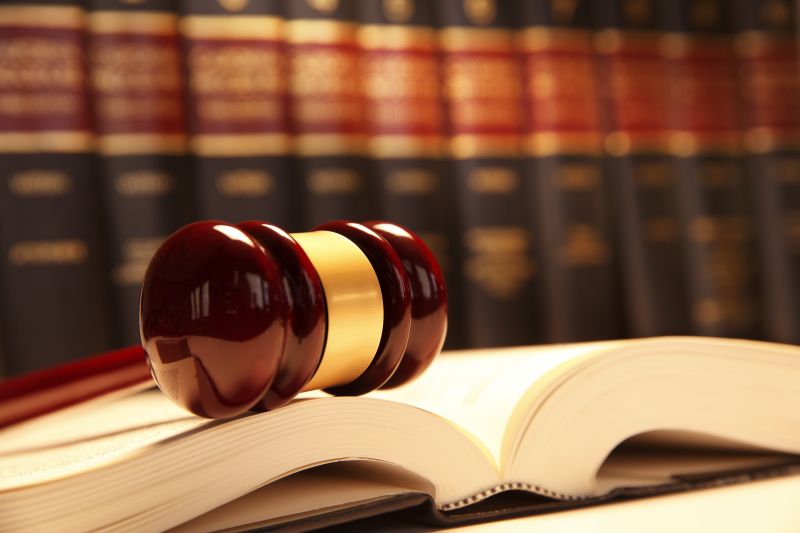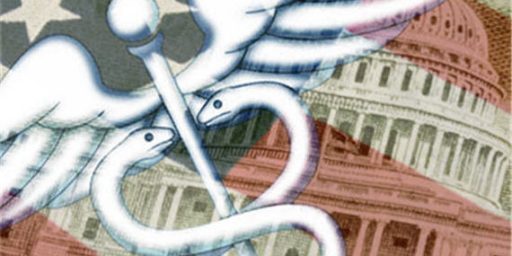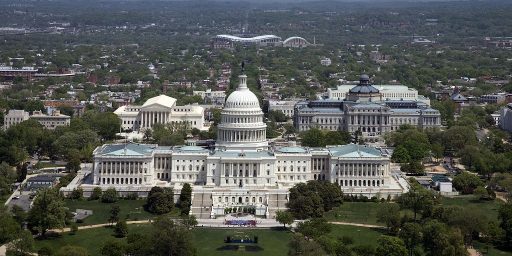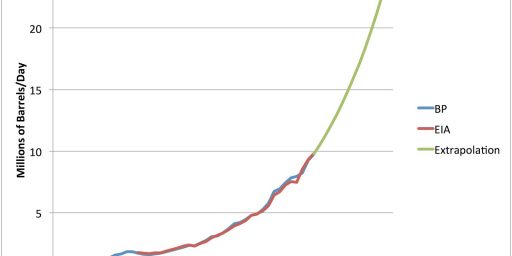Second Judge Says Trump Illegally Overturned Obama Regulation
Presidents are much more constrained in issuing and rolling back regulations than they or the public think.
From the AP (“Second judge says Trump can’t keep stalling clean-air rules“):
A second judge has told the Trump administration it can’t keep stalling clean-air rules for oil and gas production on federal lands.
U.S. District Judge William Orrick of the Northern District of California ordered the Interior Department to reinstate the Obama-era regulation aimed at restricting harmful methane emissions. Orrick said late Thursday the administration’s delay is “untethered to evidence” and likely to cause “irreparable injury” to California, New Mexico and other states from increased air pollution and negative impacts on public health and the climate.
The ruling marked the second time a federal judge has rebuffed the Trump administration for failing to enforce the methane rule. U.S. Magistrate Judge Elizabeth Laporte rejected an earlier effort by Interior to postpone part of the rule and ordered the Obama rule reinstated in October. Laporte serves on the same court, which is based in San Francisco.
Interior Secretary Ryan Zinke told The Associated Press Friday that officials will carefully review the judge’s 29-page ruling.
Federal rules “are not intended to be adversarial” to the industry, Zinke said, adding that the Obama-era rule “penalizes oil and gas,” while the Trump administration wants to encourage the industry to voluntarily find ways to capture and re-use methane.
The rule forced energy companies to capture methane that’s burned off or “flared” at drilling sites because it pollutes the environment. Many companies consider the rule unnecessary and overly intrusive, but environmental groups warn that methane emissions from oil and gas operations are the second largest industrial contributor to climate change in the United States. Methane is far more potent at trapping heat than carbon dioxide but does not stay in the air as long.
The Interior Department said earlier this month it is replacing the Obama-era rule with requirements similar to those in force before the Obama administration changed the regulation in 2016.
I’ve got no real opinion one way or the other on the regulations in question, although strongly lean towards the judge’s view that the Obama EPA’s approach was more likely to be in good faith than the Trump EPA’s. But I continue to be baffled by the notion that things that are within the executive purview of one president aren’t in the executive purview of his successor. President Obama, frustrated by his inability to get anything through a Congress bound and determined to thwart any legislation he proposed on the mere basis that he proposed it, relied heavily on Executive Orders and other fiat measures. But, almost by definition, anything that he had the power to do in that fashion, Trump has the power to undo. Conversely, if he lacked the power to do it, Trump doesn’t need to undo it because it was never legitimate.
It gets more complicated, still, with regulations. Regulatory power is somewhat more constrained, in that it’s governed by the Administrative Procedure Act. Given that the law was designed to protect the public and industry from arbitrary and capricious new regulations, it stands to reason that restoring the status quo ante—to 2016—and actually lowering the amount of regulation imposed on industry isn’t a new regulatory burden that ought be subject to judicial review. But, apparently, that’s not how the law has been generally understood.
Maeve P. Carey, Specialist in Government Organization and Management for the Congressional Research Service, explains:
Following the election of Donald J. Trump on November 8, 2016, questions have been raised as to whether and how a new President’s administration can amend or repeal regulations issued by the previous administration. In short, once a rule has been finalized, a new administration would be required to undergo the rulemaking process to change or repeal all or part of the rule. If a rule has not yet been finalized, however, a new President may be able, immediately upon taking office, to prevent the rule from being issued. In addition to these administrative actions, Congress can also take legislative action to overturn rules.
Changing or Repealing Previously Issued Rules
Under the Administrative Procedure Act (APA), “rulemaking” is defined as “formulating, amending, or repealing a rule,” meaning that an agency must follow the rulemaking procedures set forth by the APA and other statutory and executive order requirements to change or repeal a rule. (For more on these procedures, see CRS Report RL32240, The Federal Rulemaking Process: An Overview, coordinated by Maeve P. Carey.)
Under the APA’s rulemaking procedures, agencies are generally required to publish a notice of proposed rulemaking (NPRM) in the Federal Register, allow “interested persons” an opportunity to comment on the proposed rule, and, after considering those comments, publish the final rule. Furthermore, in most cases, the final rule may not become effective until at least 30 days after its publication. Sometimes Congress has required agencies to undertake additional or alternative procedures to issue rules. Such procedures are not addressed here, but also may be required for an agency to amend or repeal a previously issued rule. [Numerous hyperlinks contained in the PDF didn’t port over. Follow the link if you’re interested in her sources.]
Stuart Shapiro, an associate professor and director of the Public Policy Program at Rutgers University, expands:
Over the past several decades, regulation has become one of the most powerful tools a president has for setting policy. As such, it has become an increasing source of rhetoric from the people who want to be president. Real estate mogul Donald Trump (R) has said that he would “get rid of the regulations that are destroying us.” New Jersey Gov. Chris Christie (R) has pledged a six-month freeze on regulations. Sen. Bernie Sanders (I-Vt.) has promised to go beyond President Obama in leading the world on climate change.
While regulation is a powerful policy-making tool, presidents do not have unfettered power to regulate or deregulate. What should we make of campaign promises regarding regulation? Let’s look at the Republicans first, who largely promise to roll back the Obama era regulations, particularly on the environment and on the financial sector.The easiest regulations for a new Republican president to rescind will be those passed at the very end of the Obama administration. All recent presidents have suspended the effective date of regulations issued by their predecessors that had not yet gone into effect. While the effective date is suspended, the new administration can decide whether it wants to begin a regulatory process to repeal the regulation, and in doing so perhaps ensure that the regulation never takes effect. In practice, however, this impacts a small number of regulations, and virtually none of the ones being discussed by the presidential candidates.
For regulations issued in approximately the last eight months of the Obama administration, the new administration can ask Congress to use the Congressional Review Act. This law allows Congress to bypass filibusters in the Senate to overturn recently issued regulations. While this is a more powerful tool, it could not be used on any regulations issued before May 2016 and it has only been used successfully once since it was passed in 1996.
That leaves three options for an incoming presidents with a deregulatory agenda, none of them easy. He or she could ask Congress to pass a law overturning potential regulations, but this requires a filibuster proof majority in the Senate, something that it will be virtually impossible for Republicans to achieve. He or she could hope that judges overturn the regulations, which will happen in a few cases (regardless of whom the next president is), but not in many (regardless of whom the next president is). Or the new president can use the regulatory process to reverse previous regulations, but this will take years and courts do not often look kindly on such efforts.
What about Democratic pledges from candidates to use regulation to implement their agendas? Well, they are more likely to be able to follow through, compared to Republicans who pledge to roll back regulation, but the more ambitious the goal, the less likely it will be that regulations can be used to achieve it. Despite the rhetoric about presidents using regulation to exceed their authority, regulations must be issued pursuant to a statute passed by Congress. While courts are somewhat deferential to executive branch agencies issuing regulations, there are prominent exceptions, including examples where high-priority regulations from the Obama administration and the George W. Bush administration were overturned by the courts.
The confusion is fed by candidates and presidents making promises that they can’t really keep on their own authority and by the apparent similarity between Executive rule-making, a quasi-regulatory authority delegated by Congress, and Executive Orders, an inherent power claimed by Presidents in their role as Chief Executive. Trump could presumably simply order the EPA not to expend any of their limited resources in enforcing the Obama Administration’s regulations through Executive Order. But he can’t simply roll back regulations on his own power without going through the statutory procedures.







“Second Judge Confirms Himself to be Driven by Ideology Rather Than the Law”
Fixed the headline for you.
You’re welcome. A little wordy, perhaps, but more to the point.
The APA indicates how regulations get changed. The Trump Administration isn’t following the rules.
You may think it is clear in this case that going back to an earlier regulatory state isn’t imposing a new regulatory burden but the Court can’t and shouldn’t presume that is true. We have rules for a reason – to prevent arbitrary and capricious behavior. The Trump Administration needs to follow the rules.
Well, this was a BLM rule, not an EPA rule (although there was a similar rule at EPA). And, I am not a lawyer, but it doesn’t seem correct to me to say that Obama’s rule was done by “fiat” or Executive Order. It was an ordinary regulation that went through the public comment process, and was based on Mineral Leasing Act powers designated by Congress.
And in your last paragraph it seems to me that you are saying Trump would have the power to arbitrarily remove any regulation he wants simply by “restoring the status quo ante?” That can’t be right. The President doesn’t have a blank check to uproot any regulation he wants without judicial review. The factual basis of the case matters I think, and it doesn’t surprise me that a judge would find DOI’s arguments unpersuasive. At lot of Bush enviro rollbacks got struck down as well (mercury rule and particulate matter, off the top of my head).
EDIT: I see the post has been updated. Carry on.
@SKI:
I do think rolling back rules is different from imposing new ones, given that the clear purpose of the APA was to protect the public and industry from capricious regulation. But courts have ruled in this manner for a while now.
@SKI: This makes sense to me. Have the courts generally acted in line with this previous to the current administration?
@Turgid Jacobian: yes (as James noted above)
In effect, these judges will now be making laws. How about Congress? They need to get busy on this. Sensible environmental rules are fine. Not United Nations controls and dictates.
See “Convention of States”. Time for a return to Constitutional government.
@James Joyner:
But what if they are rolling back a regulation that itself relaxed standards from a prior regulation? And thereby restricting industry? Regulations have long lives with many, many adjustments over the years.
Who gets to decide what the impact is? The Administration? Can they just claim they are lowering the burden to avoid judicial review or compliance with the APA?
Think about it for a minute. We have rules and procedures for a reason.
@Tyrell: yeah, no. That isn’t reality.
All the Trump Administration has to do is follow the APA and they can gut regulations to their black hearts’ content. That they continue to refuse to learn or follow rules is symptomatic of the rot at their core.
@Tyrell: The judge did not make the law. This is just not true, even “in effect.” The rule is based on the fact that “The Mineral Leasing Act of 1920 (MLA) requires the BLM to ensure that lessees ‘use all reasonable precautions to prevent waste of oil or gas developed in the land.'”
@James Joyner:
Federal rulemaking isn’t the President doing things by fiat though. A President that wants to change or rollback a rule has to go through the same rulemaking process – and it’s a process that is highly bureaucratic and takes a lot of time.
It’s different from an Executive Order or other measures a President can take by executive fiat.
Like so many areas in the federal government, rule-making is one that is ripe for reform. It is de facto shadow legislation that is largely invisible to the general public.
Here’s a good overview from NPR on rulemaking. The Planet Money podcasts (also from NPR) related to this are also very informative.
https://www.npr.org/2017/01/26/511745408/how-a-law-is-implemented-depends-on-a-presidents-rules
@Tyrell: Regardless of anything else, no one is stopping Congress from acting, save Congress itself.
This is another example of federal judicial overreach gone to seed. In effect, these federal judges are now making laws, which is the province of Congress. Our Congress members should stand up and do something about the growing power of these federal judges.
There is certainly room for sensible environmental rules. But that should be from Congress, not the United Nations or some other one world government organization.
See “UN agenda 21” and “UN agenda 2030 sustainable development”. Outlines for controlling the freedoms and economy of nations.
There is something being done to restore Constitutional government. It is the Convention of States!
President George Washington warned against getting entangled in these treaties with other countries. Read General Washington’s farewell address.
@Tyrell: What color is the sky in your fantasy world?
@SKI:
Sure! Just like they claim their taxcut is going to reduce the deficit. Up is down, black is white.
@Tyrell: You really don’t have a clue, do you?
@James Joyner:
I have to disagree here.
The APA’s purpose was to ensure that Executive Branch agencies follow procedures that are open to the public and that are open to public comment. It also has requirements that agency action be based on evidence rather than ideology. Courts have thrown out regulations from both Democratic and Republican Administrations that have failed to meet these guidelines many times, although its worth noting that current precedent does instruct courts to give agencies some degree of deference in interpreting the laws they are charged with enforcing via regulation, but that deference is not total. These criteria apply regardless of whether an agency is enacting a new regulation or repealing an old one.
@Doug Mataconis:
This makes sense, to some degree. On its face, it seems reasonable to me that a new administration ought be able to undo 11th-hour regulations imposed by its predecessor. In this particular case, the result is rolling back regulations. But I could see how this could be abused.
@Doug Mataconis: As to the legislative purpose, this comports with my cursory understanding:
@James Joyner:
Well since many of those 11th hour regulations may have been adopted without complying with the APA, then it’s possible that there could be a short-cut to undo them. Barring that, there is the Congressional Review Act, which was used several times during Trump’s first year to repeal Obama-Era regulations.
Thought it was curious that there was a Mineral Leasing Act of 1920. (The perils of being a History major!) Turns out that the MLA of 1920 was passed to insure that the Navy would have large reserves of their new fuel as oil had replaced coal.
And the Harding administration began adjusting the areas of responsibility for oil-bearing areas so that the Navy actually administered those oil rich tracts.
BUT! The result of their changing these federal rules was: The Teapot Dome Scandal.
Hmmm…. Federal rulemaking has consequences. Dr Joyce! Whocudanoed?
That Lord Acton business?